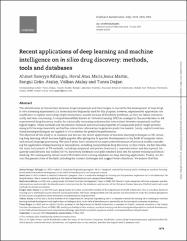| dc.contributor.author | Rifaioğlu, Ahmet Süreyya | |
| dc.contributor.author | Ataş, Heval | |
| dc.contributor.author | Martin, Maria Jesus | |
| dc.contributor.author | Çetin-Atalay, Rengül | |
| dc.contributor.author | Atalay, Volkan | |
| dc.contributor.author | Doğan, Tunca | |
| dc.date.accessioned | 2020-05-24T15:32:02Z | |
| dc.date.available | 2020-05-24T15:32:02Z | |
| dc.date.issued | 2019 | |
| dc.identifier.citation | Rifaioglu AS, Atas H, Martin MJ, Cetin-Atalay R, Atalay V, Doğan T. Recent applications of deep learning and machine intelligence on in silico drug discovery: methods, tools and databases. Brief Bioinform. 2019;20(5):1878‐1912. doi:10.1093/bib/bby061 | en_US |
| dc.identifier.issn | 1467-5463 | |
| dc.identifier.issn | 1477-4054 | |
| dc.identifier.uri | https://doi.org/10.1093/bib/bby061 | |
| dc.identifier.uri | https://hdl.handle.net/20.500.12508/1187 | |
| dc.description | Rifaioglu, Ahmet Sureyya/0000-0001-6717-4767; Dogan, Tunca/0000-0002-1298-9763; Martin, Maria-Jesus/0000-0001-5454-2815 | en_US |
| dc.description | WOS: 000509119800021 | en_US |
| dc.description | PubMed ID: 30084866 | en_US |
| dc.description.abstract | The identification of interactions between drugs/compounds and their targets is crucial for the development of new drugs. In vitro screening experiments (i.e. bioassays) are frequently used for this purpose; however, experimental approaches are insufficient to explore novel drug-target interactions, mainly because of feasibility problems, as they are labour intensive, costly and time consuming. A computational field known as 'virtual screening' (VS) has emerged in the past decades to aid experimental drug discovery studies by statistically estimating unknown bio-interactions between compounds and biological targets. These methods use the physico-chemical and structural properties of compounds and/or target proteins along with the experimentally verified bio-interaction information to generate predictive models. Lately, sophisticated machine learning techniques are applied in VS to elevate the predictive performance. The objective of this study is to examine and discuss the recent applications of machine learning techniques in VS, including deep learning, which became highly popular after giving rise to epochal developments in the fields of computer vision and natural language processing. The past 3 years have witnessed an unprecedented amount of research studies considering the application of deep learning in biomedicine, including computational drug discovery. In this review, we first describe the main instruments of VS methods, including compound and protein features (i.e. representations and descriptors), frequently used libraries and toolkits for VS, bioactivity databases and gold-standard data sets for system training and benchmarking. We subsequently review recent VS studies with a strong emphasis on deep learning applications. Finally, we discuss the present state of the field, including the current challenges and suggest future directions. We believe that this survey will provide insight to the researchers working in the field of computational drug discovery in terms of comprehending and developing novel bio-prediction methods. | en_US |
| dc.description.sponsorship | Turkish Ministry of Development, KanSiL project [KanSil_2016K121540]; Newton/Katip Celebi Institutional Links program by TUBITAK, TurkeyTurkiye Bilimsel ve Teknolojik Arastirma Kurumu (TUBITAK); British Council, UK [116E930]; European Molecular Biology Laboratory core funds | en_US |
| dc.description.sponsorship | This work was supported by the Turkish Ministry of Development, KanSiL project (KanSil_2016K121540); the Newton/Katip Celebi Institutional Links program by TUBITAK, Turkey and British Council, UK (project no: 116E930); and the European Molecular Biology Laboratory core funds. | en_US |
| dc.language.iso | eng | en_US |
| dc.publisher | Oxford Univ Press | en_US |
| dc.relation.isversionof | 10.1093/bib/bby061 | en_US |
| dc.rights | info:eu-repo/semantics/openAccess | en_US |
| dc.subject | Virtual Screening | en_US |
| dc.subject | Drug-target Interactions | en_US |
| dc.subject | Ligand-based VS and Proteochemometric Modelling | en_US |
| dc.subject | Machine Learning | en_US |
| dc.subject | Deep Learning | en_US |
| dc.subject | Compound and Bioactivity Databasesen | en_US |
| dc.subject | Gold-Standard Data Sets | en_US |
| dc.subject.classification | Biochemical research methods | en_US |
| dc.subject.classification | Mathematical & computational biology | en_US |
| dc.subject.classification | Pharmaceutical Preparations | Drug Discovery | Drug-target interaction | en_US |
| dc.subject.other | Large-scale prediction | en_US |
| dc.subject.other | Measuring semantic similarity | en_US |
| dc.subject.other | Target interactions | en_US |
| dc.subject.other | Protein-structure | en_US |
| dc.subject.other | Web server | en_US |
| dc.subject.other | Neural-networks | en_US |
| dc.subject.other | Physicochemical features | en_US |
| dc.subject.other | Topological descriptors | en_US |
| dc.subject.other | Molecular docking | en_US |
| dc.subject.other | Scoring functions | en_US |
| dc.title | Recent applications of deep learning and machine intelligence on in silico drug discovery: methods, tools and databases | en_US |
| dc.type | review | en_US |
| dc.relation.journal | Briefings In Bioinformatics | en_US |
| dc.contributor.department | Mühendislik ve Doğa Bilimleri Fakültesi -- Bilgisayar Mühendisliği Bölümü | en_US |
| dc.identifier.volume | 20 | en_US |
| dc.identifier.issue | 5 | en_US |
| dc.identifier.startpage | 1878 | en_US |
| dc.identifier.endpage | 1912 | en_US |
| dc.relation.publicationcategory | Diğer | en_US |
| dc.contributor.isteauthor | Rifaioğlu, Ahmet Süreyya | en_US |
| dc.relation.index | Web of Science Core Collection - Science Citation Index Expanded | |
















